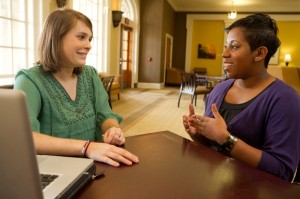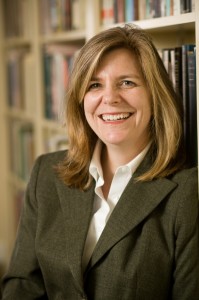Wake at Work: Class project focuses on faculty and staff work experiences

Senior Rebecca Hinson, at left, interviews academic advisor Tiffany Waddell for her Wake at Work oral history project.
Students in Michele Gillespie’s history class are studying the history of work in America by starting with those who make Wake Forest work: staff and faculty.
Using the University as an example of the contemporary workplace exposes students to a variety of jobs before they begin their journey back to colonial days to trace how work — individually and collectively — has shaped American history and expectations about the American Dream today, Gillespie said.
“It gives us a starting point for talking about the impact of 400 years of seismic economic and political shifts of occupations and opportunities in the American experience, and how the vestiges of those changes continue to play out today,” said Gillespie, the Kahle Associate Professor of History. “The project also helps students understand the variety of work taking place at Wake Forest on a daily basis that makes the mission of the University possible. And I hope it will build more meaningful face-to-face relationships between students and employees.”
 Read more campus news at Inside WFU
Read more campus news at Inside WFU- February 2011 Staff Milestones
- Featured Employee: Craig Fansler, Z. Smith Reynolds Library
The students in her upper-level class, America at Work, are studying how what people do has shaped the nation’s history, from the colonial era through the slave economy and Reconstruction; from the Great Depression to the post-war business boom; and from the rise and decline of manufacturing to the transition to the service economy today.
As part of an oral-history project, Wake at Work, students are interviewing about 20 staff members and several professors, asking them about their family background and how that influenced what they wanted to do when they grew up; how they chose their particular occupation and why they came to work at Wake Forest; what they do now and what they like about their job; and their hopes for the future for themselves and their children. Transcripts from the interviews will be published on a website later this year.
Gillespie collaborated with the Human Resources Office, which selected the staff members to be interviewed to represent a range of occupations and offices. Angela Culler, interim assistant vice president of human resources, said she was pleased to help students make connections with staff members. “I hope students will better understand how staff contribute to the University’s educational mission and what it takes for the University to operate.”
Students are interviewing staff members in Admissions, Athletics, University Advancement, Career Development, Facilities and Campus Services, Financial and Accounting Services and in other offices, and at Graylyn International Conference Center and Reynolda House Museum of American Art.
“I want students to think about the diversity of work experiences in the U.S. today,” Gillespie said. “Wake Forest does not begin to approximate the full diversity of work in the world, but it does offer a good representation.”
— By Kerry M. King (’85), Office of Communications and External Relations
Categories: University Announcements
